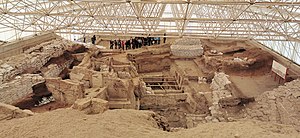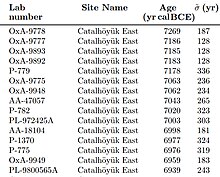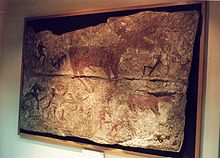Çatalhöyük
 Ruins of Çatalhöyük | |
| Location | Küçükköy, Konya Province, Turkey |
|---|---|
| Region | Anatolia |
| Coordinates | 37°40′00″N 32°49′41″E / 37.66667°N 32.82806°E |
| Type | Settlement |
| History | |
| Founded | Approximately 7100 BC; 9124 years ago |
| Abandoned | Approximately 5700 BC; 7724 years ago |
| Periods | Neolithic to Chalcolithic |
| Official name | Neolithic Site of Çatalhöyük |
| Type | Cultural |
| Criteria | iii, iv |
| Designated | 2012 (36th session) |
| Reference no. | 1405 |
| Region | Southern Europe and Western Asia |

Çatalhöyük (Turkish pronunciation:
Çatalhöyük overlooks the
Archaeology

The site was first excavated by James Mellaart in 1958. He later led a team which further excavated there for four seasons between 1961 and 1965.[4][5][6][7] These excavations revealed this section of Anatolia as a centre of advanced culture in the Neolithic period.[8] Excavation revealed 18 successive layers of buildings signifying various stages of the settlement and eras of history. The bottom layer of buildings can be dated as early as 7100 BC while the top layer is from 5600 BC.[9]
Mellaart was banned from Turkey for his involvement in the Dorak affair, in which he published drawings of supposedly important Bronze Age artifacts that later went missing.[10] After this scandal, the site lay idle until 1993, when investigations began under the leadership of Ian Hodder, then at the University of Cambridge.[11][12][13][14][15] The Hodder led excavations ended in 2018. Hodder, a former student of Mellaart, chose the site as the first "real world" test of his then-controversial theory of post-processual archaeology.[16] The site has always had a strong research emphasis upon engagement with digital methodologies, driven by the project's experimental and reflexive methodological framework.[17] According to Mickel, Hodder's Çatalhöyük Research Project (ÇRP) established itself as a site for progressive methodologies - in terms of adaptable and democratized recording, integration of computerized technologies, sampling strategies, and community involvement."[18]
New excavations are being directed by Ali Umut Türkcan from Anadolu University.
Culture



Çatalhöyük was composed entirely of domestic buildings with no obvious public buildings. While some of the larger rooms have rather ornate
The population of the eastern mound has been estimated to be around 10,000 people, but the population likely varied over the community's history. An average population of between 5,000 and 7,000 is a reasonable estimate. The sites were set up as large numbers of buildings clustered together. Households looked to their neighbors for help, trade, and possible marriage for their children.[19] The inhabitants lived in mudbrick houses that were crammed together in an aggregate structure. No footpaths or streets were used between the dwellings, which were clustered in a honeycomb-like maze. Most were accessed by holes in the ceiling and doors on the side of the houses, with doors reached by ladders and stairs. The rooftops were effectively streets. The ceiling openings also served as the only source of ventilation, allowing smoke from the houses' open hearths and ovens to escape. Houses had
All rooms were kept scrupulously clean. Archaeologists identified very little rubbish in the buildings, finding
As a part of ritual life, the people of Çatalhöyük buried their dead within the village.

Vivid
figures are carved on walls, such as of lionesses facing one another.Heads of animals, especially of cattle, were mounted on walls. A painting of the village, with the twin mountain peaks of Hasan Dağ in the background,[23] is frequently cited as the world's oldest map,[24] and the first landscape painting.[8] However, some archaeologists question this interpretation. Stephanie Meece, for example, argues that it is more likely a painting of a leopard skin instead of a volcano, and a decorative geometric design instead of a map.[25]
Religion



A feature of Çatalhöyük are its female figurines. Mellaart, the original excavator, argued that these carefully made figurines, carved and molded from
Whereas Mellaart excavated nearly two hundred buildings in four seasons, the current excavator, Ian Hodder, spent an entire season excavating one building alone.
There are full breasts on which the hands rest, and the stomach is extended in the central part. There is a hole in the top for the head which is missing. As one turns the figurine around one notices that the arms are very thin, and then on the back of the figurine one sees a depiction of either a skeleton or the bones of a very thin and depleted human. The ribs and vertebrae are clear, as are the scapulae and the main pelvic bones. The figurine can be interpreted in a number of ways – as a woman turning into an ancestor, as a woman associated with death, or as death and life conjoined. It is possible that the lines around the body represent wrapping rather than ribs. Whatever the specific interpretation, this is a unique piece that may force us to change our views of the nature of Çatalhöyük society and imagery. Perhaps the importance of female imagery was related to some special role of the female in relation to death as much as to the roles of mother and nurturer.[30]
In an article in the
In a report in September 2009 on the discovery of around 2000 figurines Hodder is quoted as saying:
Çatalhöyük was excavated in the 1960s in a methodical way, but not using the full range of natural science techniques that are available to us today. Sir James Mellaart who excavated the site in the 1960s came up with all sorts of ideas about the way the site was organized and how it was lived in and so on ... We've now started working there since the mid 1990s and come up with very different ideas about the site. One of the most obvious examples of that is that Çatalhöyük is perhaps best known for the idea of the mother goddess. But our work more recently has tended to show that in fact there is very little evidence of a mother goddess and very little evidence of some sort of female-based matriarchy. That's just one of the many myths that the modern scientific work is undermining.[33]
Professor Lynn Meskell explained that while the original excavations had found only 200 figures, the new excavations had uncovered 2,000 figures, most of which depicted animals, and fewer than 5% of the figurines depicted women.[33]
Estonian folklorist Uku Masing has suggested as early as in 1976, that Çatalhöyük was probably a hunting and gathering religion and the Mother Goddess figurine did not represent a female deity. He implied that perhaps a longer period of time was needed to develop symbols for agricultural rites.[34] His theory was developed in the paper "Some remarks on the mythology of the people of Catal Hüyük".[35]
Economy
Çatalhöyük has strong evidence of an egalitarian society, as no houses with distinctive features (belonging to royalty or religious hierarchy for example) have been found so far. The most recent investigations also reveal little social distinction based on gender, with men and women receiving equivalent nutrition and seeming to have equal social status, as typically found in Paleolithic cultures.[36][37] Children observed domestic areas. They learned how to perform rituals and how to build or repair houses by watching the adults make statues, beads, and other objects.[19] Çatalhöyük's spatial layout may be due to the close kin relations exhibited amongst the people. It can be seen, in the layout, that the people were "divided into two groups who lived on opposite sides of the town, separated by a gully." Furthermore, because no nearby towns were found from which marriage partners could be drawn, "this spatial separation must have marked two intermarrying kinship groups." This would help explain how a settlement so early on would become so large.[38]

In the upper levels of the site, it becomes apparent that the people of Çatalhöyük were honing skills in agriculture and the domestication of animals. Female figurines have been found within bins used for storage of cereals, such as wheat and
Conversely, a 2014 paper argues that the picture of Çatalhöyük is more complex and that while there seemed to have been an egalitarian distribution of cooking tools and some stone tools, unbroken quern-stones and storage units were more unevenly distributed. Private property existed but shared tools also existed. It was also suggested that Çatalhöyük was becoming less egalitarian, with greater inter-generational wealth transmission.[40]
See also
- Boncuklu Höyük
- Cities of the ancient Near East
- Cucuteni–Trypillian culture
- Göbekli Tepe
- Kamyana Mohyla
- List of largest cities throughout history
- List of Stone Age art
- Matriarchy
- Neolithic Revolution
- Old Europe (archaeology)
- Sacred bull
- Venus figurines
References
- PMID 24806472.
- .
- ^ [1] Çatalhöyük entry on the UNESCO World Heritage List site
- ^ J. Mellaart, Excavations at Çatal Hüyük, first preliminary report: 1961. Anatolian Studies, vol. 12, pp. 41–65, 1962
- ^ J. Mellaart, Excavations at Çatal Hüyük, second preliminary report: 1962. Anatolian Studies, vol. 13, pp. 43–103, 1963
- ^ J. Mellaart, Excavations at Çatal Hüyük, third preliminary report: 1963. Anatolian Studies, vol. 14, pp. 39–119, 1964
- ^ J. Mellaart, Excavations at Çatal Hüyük, fourth preliminary report: at 1965. Anatolian Studies, vol. 16, pp. 15–191, 1966
- ^ ISBN 978-0-495-00479-0.
- ^ [2] David Orton et al., A tale of two tells: dating the Çatalhöyük West Mound, Antiquity, vol. 92, iss. 363, pp. 620–639, June 2018
- ^ Kenneth Pearson and Patricia Connor, The Dorak affair, New York, Atheneum, 1968
- ^ I. Hodder, Çatalhöyük, Anatolian Archaeology, vol. 4, pp. 8–10, 1998
- ^ I. Hodder, Getting to the Bottom of Thing: Çatalhöyük 1999, Anatolian Archaeology, vol. 5, pp. 4–7, 1999
- ^ I. Hodder, Çatalhöyük, Anatolian Archaeology, vol. 8, pp. 5–7, 2002
- ^ I. Hodder, A New Phase of Excavation at Çatalhöyük, Anatolian Archaeology, vol. 9, pp. 9–11, 2003
- ^ [3] Çatalhöyük: Excavations of a Neolithic Anatolian Höyük – Çatalhöyük Archive Report 2008
- doi:10.11141/ia.42.7. Archived(PDF) from the original on 10 October 2022.
- doi:10.11141/ia.47.1.
- ISBN 9781646421152.
- ^ ISBN 978-0-19-530476-3.
- (PDF) from the original on 10 October 2022.
- ^ "Neolithic Site of Çatalhöyük". UNESCO World Heritage Centre. Retrieved 4 January 2020.
- ^ "Incredible discovery of intact female figurine from neolithic era in Turkey | Ars Technica". 16 September 2016.
- ^ Noah Wiener (1 November 2013). "Çatalhöyük mural". Bible History Daily. Biblical Archaeology Society. Archived from the original on 5 November 2013.
This Çatalhöyük mural is thought to represent a nearby volcanic eruption. New scientific evidence confirms a contemporaneous eruption at nearby Hasan Dağ.
Alt URL - ^ Cartographic Images (accessed 23 February 2014)
- ^ A bird's eye view – of a leopard's spots. The Çatalhöyük 'map' and the development of cartographic representation in prehistory. Anatolian Studies 56, 2006, pp. 1–16. Published by The British Institute of Archaeology at Ankara
- McGraw-Hill. p. 181.
- ^ Mellaart (1967), 180.
- ISBN 978-0-7432-4360-5.
- ^ "Çatalhöyük: Ancient History of the Anatolia".
- ^ Hodder, Ian (2005). "New finds and new interpretations at Çatalhöyük". Çatalhöyük 2005 Archive Report. Catalhoyuk Research Project, Institute of Archaeology.
- ^ Hodder, Ian (1 January 2008). "A Journey to 9000 years ago". Retrieved 7 August 2008.
- ^ Hodder, Ian (2 March 2015). "Çatalhöyük excavations reveal gender equality in ancient settled life". Retrieved 25 March 2015.
- ^ a b O'Brien, Jeremy "New techniques undermine 'mother goddess' role in the community" Irish Times September 20, 2009 [4]
- ISBN 978-9985-77-351-2.
- ^ Oriental Studies 3. Acta et Commentationes Universitatis Tartuensis 392 / Tartu Riikliku Ülikooli Toimetised 392. Tartu 1976, 75–92.
- ISBN 978-0-13-357005-2. Pages 9–13
- ISBN 978-0-19-530476-3.
- ^ Bookchin, Murray. The Rise of Urbanisation and Decline of Citizenship. pp. 18–22.
- ^ Wright, Katherine I. Karen. "Domestication and inequality? Households, corporate groups and food processing tools at Neolithic Çatalhöyük." Journal of Anthropological Archaeology 33 (2014): 1–33.
Sources
- Bailey, Douglass. Prehistoric Figurines: Representation and Corporeality in the Neolithic. New York: Routledge, 2005 (hardcover, ISBN 0-415-33152-8).
- ISBN 1-59874-069-5). A highly condensed version was published in The Smithsonian Magazine, May 2005.
- Dural, Sadrettin. "Protecting Catalhoyuk: Memoir of an Archaeological Site Guard." Contributions by Ian Hodder. Translated by Duygu Camurcuoglu Cleere. Walnut Creek, CA: Left Coast Press, 2007. ISBN 978-1-59874-050-9.
- Hodder, Ian. "Women and Men at Çatalhöyük," Scientific American Magazine, January 2004 (update V15:1, 2005).
- Hodder, I. (2014). "Çatalhöyük excavations: the 2000-2008 seasons.", British Institute at Ankara, Monumenta Archaeologica 29, ISBN 978-1-898249-29-0
- Hodder, Ian. Twenty-Five Years of Research at Çatalhöyük, Near Eastern Archaeology; Chicago, vol. 83, iss. 2, pp. 72–29, June 2020
- Hodder, Ian. The Leopard's Tale: Revealing the Mysteries of Çatalhöyük. London; New York: Thames & Hudson, 2006 (hardcover, ISBN 0-500-05141-0). (The UK title of this work is Çatalhöyük: The Leopard's Tale.)
- Hodder, Ian; Bogaard, Amy; Engel, Claudia; Pearson, Jessica; Wolfhagen, Jesse., "Spatial autocorrelation analysis and the social organisation of crop and herd management at Çatalhöyük", Anatolian Studies, London, vol. 72, pp. 1–15, 2022
- Mallett, Marla, "The Goddess from Anatolia: An Updated View of the Catak Huyuk Controversy," in Oriental Rug Review, Vol. XIII, No. 2 (December 1992/January 1993).
- Mellaart, James. Çatal Hüyük: A Neolithic Town in Anatolia. London: Thames & Hudson, 1967; New York: McGraw-Hill Book Company, 1967. Online at archive.org
- On the Surface: Çatalhöyük 1993–95, edited by Ian Hodder. Cambridge: McDonald Institute for Archaeological Research and British Institute of Archaeology at Ankara, 1996 (ISBN 0-9519420-3-4).
- Taylor, James Stuart (2016), Making Time For Space At Çatalhöyük: GIS as a tool for exploring intra-site spatiotemporality within complex stratigraphic sequences (PhD thesis), University of York

- Todd, Ian A. Çatal Hüyük in Perspective. Menlo Park, CA: Cummings Pub. Co., 1976 (ISBN 0-8465-1957-7).
External links
- What we learned from 25 Years of Research at Catalhoyuk - Ian Hodder - Oriental Institute lecture Dec 4, 2019
- Çatalhöyük — Excavations of a Neolithic Anatolian Höyük, Çatalhöyük excavation official website
- Çatalhöyük photos
- The First Cities: Why Settle Down? The Mystery of Communities, by Michael Balter, Çatalhöyük excavation official biographer
- Interview with Ian Hodder March 201 "Ian Hodder: Çatalhöyük, Religion & Templeton's 25%"



